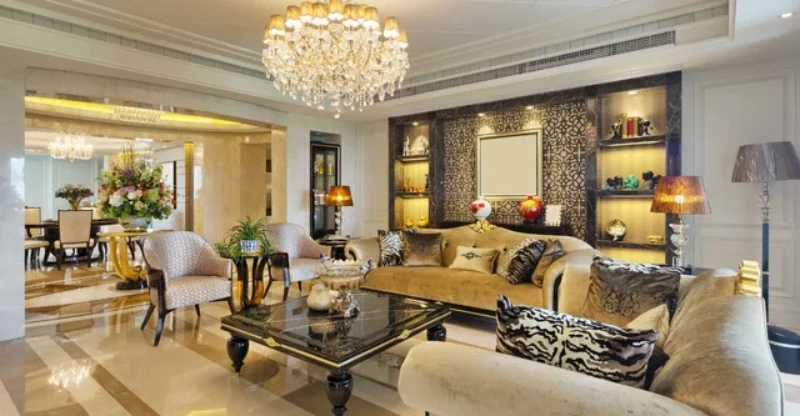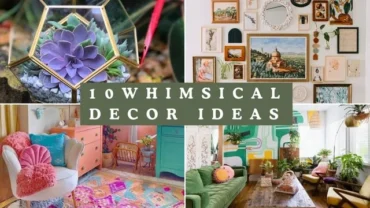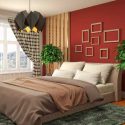11 Luxury Living Room Ideas to Elevate Your Space
Your living room is more than just a place to relax; it’s the heart of your home where cherished moments unfold, guests feel welcomed, and your unique personality shines through.
The design of this space profoundly influences the ambiance of your entire home, setting the tone for elegance, comfort, and warmth.
A well-designed luxury living room can transform your entire home, making it feel elegant and inviting. This guide explores 11 actionable ideas to elevate your living space, combining comfort, functionality, and sophistication. Let’s dive into the world of luxury living room decor.
1. Choose Quality Furniture
Luxury begins with the foundation which is your furniture. High-quality furniture defines the character of a living room, serving both aesthetic and functional purposes.
Investing in premium pieces may require a higher upfront cost, but the benefits far outweigh the expense in terms of durability, timeless appeal, and overall comfort.
Characteristics of High-Quality Furniture
- Craftsmanship: Look for pieces that showcase expert craftsmanship, such as hand-carved details, well-joined seams, and smooth finishes. Quality craftsmanship ensures the furniture is built to last.
- Durable Materials: Opt for furniture made with robust materials like hardwoods, stainless steel, or tempered glass. Upholstery fabrics such as full-grain leather, high-thread-count linen, or performance fabrics provide both style and resilience.
- Brand Reputation: Trusted furniture brands often have a legacy of quality and service. Researching reviews and recommendations can help identify reputable manufacturers.
- Comfort and Functionality: Prioritize ergonomically designed sofas and chairs that provide support without sacrificing comfort. Functional furniture like storage ottomans or convertible tables can maximize utility while maintaining elegance.
How to Identify High-Quality Furniture
- Test sturdiness by checking weight and joint construction.
- Opt for solid wood over particle board for longevity.
- Examine finishes and upholstery stitching for precision.
A well-chosen furniture set creates a cohesive and upscale look for your living room.
2. Add a Vintage Rug
A vintage rug is not just a decorative piece; it is a defining element that can significantly elevate the visual appeal and ambiance of your living room.
When chosen thoughtfully, a vintage rug becomes the focal point that ties together the design elements of your space, creating a harmonious and inviting environment.
Characteristics of a Perfect Vintage Rug
- Timeless Elegance: Opt for Persian or Oriental rugs, known for their intricate patterns and rich history. These rugs exude sophistication and charm.
- Material and Craftsmanship: Look for rugs made of high-quality materials like wool or silk, which ensure durability and a luxurious texture.
- Unique Patterns: Vintage rugs often feature unique, handwoven designs that make them one-of-a-kind pieces.
How to Choose the Right Size
- Measure your seating area to determine the ideal rug size. A properly sized rug should anchor the furniture by extending under the front legs of sofas and chairs.
- For smaller spaces, consider a rug that defines the coffee table area without overwhelming the room.
- In larger living rooms, a large vintage rug can unify the seating arrangement and create a sense of cohesion.
Strategic Placement Tips
- Define Zones: Use the rug to delineate specific areas in open-plan living rooms, such as a conversation nook or a reading corner.
- Highlight Furniture: Place the rug beneath a central coffee table or arrange your seating to frame the rug, drawing attention to its design.
- Visual Flow: Ensure the rug’s patterns and colors complement the room’s overall palette, harmonizing with furniture and wall tones.
3. Decor Is Art
Decor is more than an accessory, it’s an artistic expression of your personality and taste. When approached thoughtfully, it transforms a living room into a gallery of ideas, memories, and aesthetic preferences, creating a space that resonates with individuality and sophistication.
How to Treat Decor as Art
- Create a Gallery Wall: Curate a collection of framed art, photographs, or mixed media pieces that reflect your interests. Arrange them symmetrically for a structured look or asymmetrically for a dynamic and eclectic vibe.
- Statement Pieces: Incorporate standout decor items like oversized sculptures, unique vases, or abstract art that draws immediate attention.
- Thematic Touches: Use decor to tell a story. For instance, nautical-inspired pieces for a coastal theme or intricate wooden carvings for a rustic ambiance.
Current Trends in Art-Inspired Decor
- Abstract Expressionism: Bold, colorful pieces that evoke emotion.
- Minimalist Decor: Clean lines and neutral tones for a contemporary touch.
- Mixed Media: Combining materials like glass, metal, and fabric to create depth and texture.
4. Raise the Shelves
Shelving is a practical yet stylish way to enhance your living room’s aesthetic while providing functional storage. Well-placed shelves can elevate the design, adding height and dimension to your space while showcasing decorative elements that reflect your style.
Choosing the Right Shelving
- Floating Shelves: Sleek and minimalist, floating shelves blend seamlessly into modern and contemporary interiors. They are perfect for displaying books, framed art, or decorative accents.
- Open Shelving Units: These provide a more structured approach while maintaining an airy, uncluttered feel. Choose designs with metal frames, wood, or glass for an elegant look.
- Built-in Shelving: Ideal for maximizing vertical space, built-in shelves can create a seamless, customized appearance while offering ample storage.
Styling Your Shelves
- Layered Decor: Combine books, sculptures, plants, and vases to create a visually appealing arrangement. Use different heights and textures for balance.
- Color Coordination: Arrange items in complementary hues to maintain a cohesive and polished aesthetic.
- Statement Pieces: Incorporate standout decor, such as an oversized vase or framed artwork, to add personality and depth.
5. Hang Statement Lighting
Lighting plays a pivotal role in setting the tone and ambiance of a luxury living room, acting as both a functional and aesthetic feature.
The right lighting choices can elevate your space, creating a sense of elegance and sophistication while also enhancing comfort and utility.
Key Characteristics of Statement Lighting
- Visual Impact: Statement lighting such as chandeliers, pendant lights, or sculptural fixtures serves as a focal point, drawing the eye and adding architectural interest.
- Versatility: Modern lighting options often come with dimmable features, allowing you to shift between bright, functional lighting and softer, ambient moods.
- Design Harmony: Lighting fixtures should complement the room’s theme, color palette, and furniture style to ensure a cohesive look.
How to Choose the Right Lighting Fixtures
- Chandeliers: Opt for crystal or modern minimalist designs depending on your decor style. Chandeliers work well in large rooms with high ceilings.
- Pendant Lights: These are perfect for defining specific areas, such as above a coffee table or seating zone.
- Wall Sconces and Table Lamps: These fixtures add layers to your lighting scheme and help balance the room’s brightness.
Matching Lighting with Room Themes
- For a contemporary space, go for sleek metal or glass fixtures with clean lines.
- In traditional rooms, ornate designs with intricate details, such as antique brass or wrought iron, work best.
- To enhance a neutral palette, choose lighting with warm tones or fabric shades to add a soft, inviting glow.
6. Add Decor for That Extra Touch
The small details in a living room can make a significant impact on the overall ambiance. Thoughtfully chosen decorative elements enhance the room’s personality, adding warmth, texture, and sophistication.
Accessories like throw pillows, sculptures, vases, and table decor help tie the design together, making the space feel intentional and complete.
Essential Decorative Elements
- Throw Pillows & Blankets: Opt for high-quality fabrics like velvet, silk, or wool in rich textures and patterns to create a cozy and luxurious feel. Mix and match colors and prints for added depth.
- Decorative Vases & Sculptures: Artistic pieces, such as ceramic vases, metallic sculptures, or handcrafted pottery, add visual interest and personality.
- Mix of Materials: Incorporate a balance of natural and refined elements, such as marble trays, wooden accents, brass figurines, and crystal accessories, to create a layered and upscale aesthetic.
How to Style Decorative Pieces
- Balance and Proportion: Arrange decor items in groups of odd numbers (e.g., three or five) to maintain an organic and visually appealing balance.
- Strategic Placement: Use open shelving, coffee tables, and console tables to display carefully curated pieces that enhance the overall decor.
- Personal Touches: Integrate meaningful elements like family heirlooms, travel souvenirs, or framed photographs to infuse warmth and character into the space.
7. Incorporate Luxury Materials
Luxury is often defined by the quality and richness of materials used in the space. Premium materials not only enhance aesthetics but also elevate the overall tactile experience, giving your living room a refined and upscale look.
High-End Material Choices
- Marble & Granite: These timeless materials work beautifully for coffee tables, side tables, and fireplaces, adding a sense of grandeur.
- Metallic Accents: Incorporate gold, silver, bronze, or brushed brass in lighting fixtures, furniture legs, and decorative accessories for a sophisticated touch.
- Plush Textiles: Choose high-thread-count fabrics like silk, cashmere, mohair, or velvet for upholstery, curtains, and throw pillows to create an opulent and inviting feel.
- Exotic Woods: Opt for high-quality wood like walnut, mahogany, or oak in furniture pieces to introduce warmth and durability.
How to Incorporate These Materials
- Furniture & Statement Pieces: Invest in furniture with elegant finishes, such as a marble coffee table or a velvet-upholstered sofa.
- Decor Accents: Use metallic candle holders, mirrored trays, or decorative bowls to subtly infuse luxury into the room.
- Wall Treatments: Consider textured wallpaper, wood paneling, or decorative moldings to enhance the walls with depth and elegance.
8. Maximize Mirrors
Mirrors can make any room feel larger and brighter by enhancing light reflection and adding depth. Strategically placing mirrors can transform a space, making it appear more open and inviting.
Effective Mirror Placement Strategies
- Balance Asymmetry: If a room feels unbalanced, use mirrors to counteract an uneven layout. Placing a mirror opposite a large piece of furniture or decor helps distribute visual weight.
- Gallery Wall Integration: Instead of standalone mirrors, incorporate them into a gallery wall with framed artwork for a curated, sophisticated look.
- Reflect Natural Light: Position mirrors directly across from windows to amplify natural daylight, making the room feel brighter and more expansive.
- Enhance Focal Points: Use mirrors behind statement furniture, such as a console table or fireplace, to highlight key features and create a sense of grandeur.
- Create Depth in Small Spaces: In narrow or compact living rooms, full-length or oversized mirrors create an illusion of depth, making the area appear more spacious.
9. Create a Focal Point
A well-defined focal point serves as the heart of your living room, drawing attention and setting the overall tone of the space.
Whether it’s a bold statement piece or an architectural feature, a thoughtfully designed focal point enhances visual interest and provides a natural arrangement anchor for the room.
Focal Point Ideas
- Fireplace: A classic focal point that adds warmth and sophistication. Highlight it with a decorative mantel, artwork, or stylish accessories.
- Oversized Artwork: A large painting or framed photography creates an instant statement wall, adding personality and artistic flair.
- Striking Furniture Piece: A bold sofa, unique coffee table, or sculptural chair can serve as the main attraction.
- Accent Wall: Use textured wallpaper, contrasting paint colors, or a gallery wall with framed prints to draw the eye.
How to Enhance Your Focal Point
- Strategic Seating Arrangement: Position furniture around the focal point to emphasize its importance and create a cohesive flow.
- Accent Lighting: Use wall sconces, spotlights, or pendant lighting to highlight key features and create ambiance.
- Layered Styling: Complement your focal point with decorative accents like plants, mirrors, or well-placed accessories to enhance its visual impact.
10. Open Up Your Living Room
A spacious, airy living room feels luxurious, inviting, and visually expansive. By optimizing layout, furniture choices, and color schemes, you can create an open and uncluttered ambiance that enhances comfort and style.
Ways to Create Openness
- Declutter & Simplify: Remove excess furniture and decor to free up space and maintain a streamlined look.
- Strategic Furniture Placement: Arrange seating to maintain clear walkways and maximize open areas. Avoid blocking windows or pathways.
- Use Light Colors: Opt for neutral and pastel shades, such as white, beige, or soft gray, to create a bright and airy feel.
- Transparent & Reflective Surfaces: Incorporate glass coffee tables, acrylic chairs, or mirrors to visually expand the room.
Ideal Furniture Choices for an Open Space
- Multi-Functional Pieces: Choose furniture that serves multiple purposes, such as ottomans with storage or nesting tables, to maximize space efficiency.
- Legged Furniture: Sofas and chairs with exposed legs create a sense of openness by allowing light to pass through.
- Low-Profile Pieces: Furniture with a lower height gives the illusion of higher ceilings and a more spacious environment.
11. Connect Your Space with Nature
Bringing the outdoors in can elevate your living room’s ambiance, fostering a sense of serenity and well-being.
Biophilic design trends are increasingly popular as they emphasize our connection with nature, which has been shown to improve mental health, reduce stress, and enhance relaxation.
Design Tips for Connecting with Nature
- Maximize Natural Light: Incorporate large windows, sliding glass doors, or even skylights to flood your living room with natural light. Consider sheer curtains to maintain privacy while allowing sunlight to enter.
- Include Organic Materials: Use materials such as reclaimed wood, natural stone, or jute for furniture and decor. These elements not only provide a rustic aesthetic but also create a tactile connection to nature.
- Add Greenery: Integrate potted plants, vertical gardens, or fresh flowers into your space. Popular choices include low-maintenance options like succulents, ferns, or snake plants, which purify the air and add vibrant colors.
- Earthy Color Palette: Choose hues inspired by nature, such as soft greens, sandy beiges, or ocean blues. This color scheme promotes a calming and harmonious environment.
- Water Features: If space permits, consider adding a small indoor fountain or aquarium. The sound of flowing water can enhance relaxation and bring a unique element to your room.
Benefits of Biophilic Design
- Boosts mental clarity and reduces anxiety.
- Enhances the aesthetic appeal with a timeless, organic vibe.
- Encourages sustainability by integrating eco-friendly materials.



